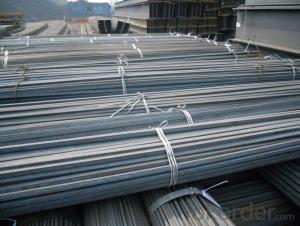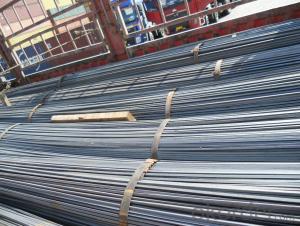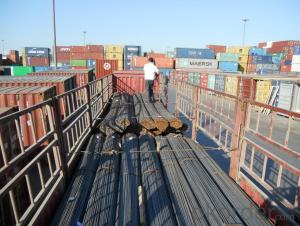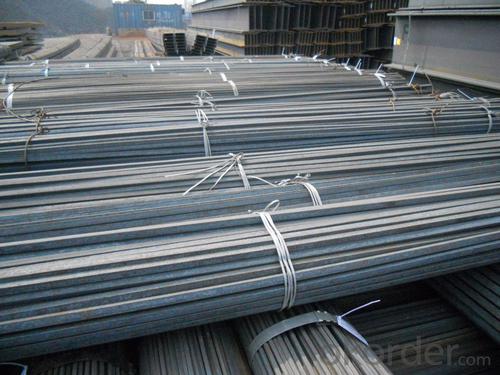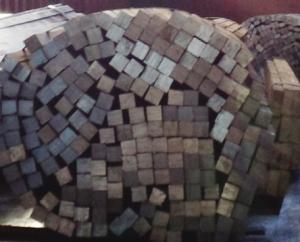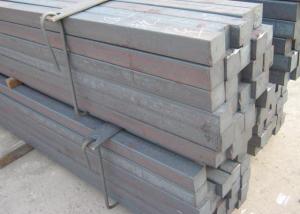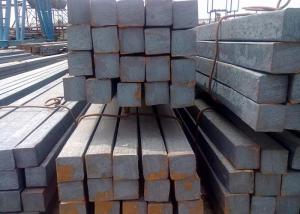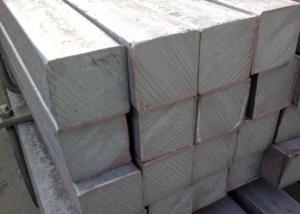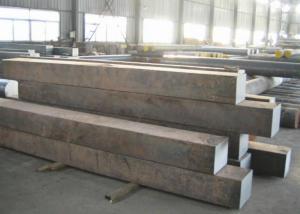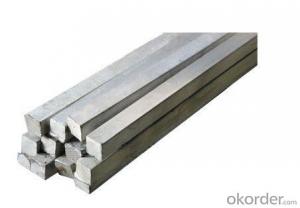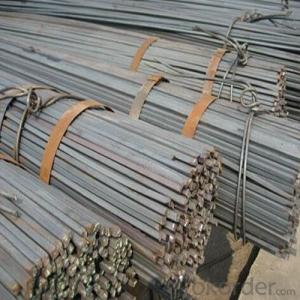Hot Rolled Square Steel
- Loading Port:
- China Main Port
- Payment Terms:
- TT or LC
- Min Order Qty:
- -
- Supply Capability:
- -
OKorder Service Pledge
OKorder Financial Service
You Might Also Like
OKorder is offering Hot rolled Square Steel at great prices with worldwide shipping. Our supplier is a world-class manufacturer of steel, with our products utilized the world over. OKorder annually supplies products to European, North American and Asian markets. We provide quotations within 24 hours of receiving an inquiry and guarantee competitive prices.
-The Square Steel is hot rolled,
-Standard: GB,
-Grade: Q195 or equivalent.
(The section of Square Steel)
Some details of Square Steel:
-List 1.The length of a side and the theoretical weight of Square Bar.
Length of a side(mm) | Theoretical weight(kg/m) | Length of a side(mm) | Theoretical weight(kg/m) |
6 | 0.283 | 32 | 8.04 |
7 | 0.385 | *33 | 8.55 |
8 | 0.502 | 34 | 9.07 |
9 | 0.636 | *35 | 9.62 |
10 | 0.785 | 36 | 10.17 |
11 | 0.950 | 38 | 11.24 |
12 | 1.13 | 40 | 12.56 |
13 | 1.33 | 42 | 13.85 |
14 | 1.54 | 45 | 15.90 |
15 | 1.77 | 48 | 18.09 |
16 | 2.01 | 50 | 19.63 |
17 | 2.27 | 53 | 22.05 |
18 | 2.54 | *55 | 23.6 |
19 | 2.82 | 56 | 24.61 |
20 | 3.14 | *58 | 26.4 |
21 | 3.46 | 60 | 28.26 |
22 | 3.80 | 63 | 31.16 |
*23 | 4.15 | *65 | 33.17 |
24 | 4.52 | *68 | 36.3 |
25 | 4.91 | 70 | 38.49 |
26 | 5.30 | 75 | 44.16 |
*27 | 5.72 | 80 | 50.24 |
28 | 6.15 | 85 | 56.72 |
*29 | 6.60 | 90 | 63.59 |
30 | 7.06 | 95 | 70.85 |
*31 | 7.54 | 100 | 78.50 |
Notes:
1, The theoretical weights in the list, base on the density of 7.85 g/cm3.
2, The numbers with *mean that they are not regulars or we don’t offer them.
-List 2. The allowed tolerance of Square Steel:
Length of a side(mm) | Allowed Tolerance | ||
Group1 | Group2 | Group3 | |
5.5~7 | ±0.20 | ±0.30 | ±0.40 |
7~20 | ±0.25 | ±0.35 | ±0.40 |
20~30 | ±0.30 | ±0.40 | ±0.50 |
30~50 | ±0.40 | ±0.50 | ±0.60 |
60~80 | ±0.60 | ±0.70 | ±0.80 |
80~110 | ±0.90 | ±1.0 | ±1.1 |
110~150 | ±1.2 | ±1.3 | ±1.1 |
150~190 | ―― | ―― | ±2.0 |
190~250 | ―― | ―― | ±2.5 |
Chemical Composition:
Standard | Grade | Element (%) | ||||
GB | Q195 | C | Mn | S | P | Si |
≤0.12 | ≤0.50 | ≤0.04 | ≤0.035 | ≤0.3 | ||
-Method of deoxidation: F, b, Z
Product Applications:
Hot rolled Square Steel are ideal for structural applications and are widely used in the construction of buildings and bridges, and the manufacturing, petrochemical, and transportation industries.
Product Advantages:
OKorder's Hot rolled Square Steel are durable, strong, and resist corrosion.
Main Product Features:
· Premium quality
· Prompt delivery & seaworthy packing (30 days after receiving deposit)
· Corrosion resistance
· Can be recycled and reused
· Mill test certification
Product Specifications:
Standard: GB
Material: Q235
Origin place: China
Thickness: 3mm-30mm
Width:20mm-200mm
Length: Max 12m
FAQ:
Q1: Why buy Materials & Equipment from OKorder.com?
A1: All products offered byOKorder.com are carefully selected from China's most reliable manufacturing enterprises. Through its ISO certifications, OKorder.com adheres to the highest standards and a commitment to supply chain safety and customer satisfaction.
Q2: How do we guarantee the quality of our products?
A2: We have established an advanced quality management system which conducts strict quality tests at every step, from raw materials to the final product. At the same time, we provide extensive follow-up service assurances as required.
Q3: How soon can we receive the product after purchase?
A3: Within three days of placing an order, we will begin production. The specific shipping date is dependent upon international and government factors, but is typically 7 to 10 workdays.
bdenum enhance this surface layer and improve the corrosion resistance of the stainless material.
Images:

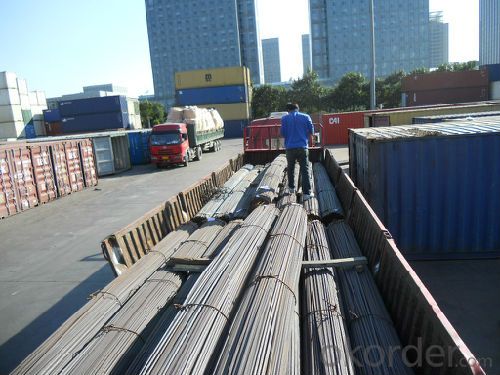
- Q: What are some common techniques for using a steel square in stair building?
- Using a steel square in stair building is essential for ensuring accuracy and precision in the construction process. Some common techniques for using a steel square in stair building include: 1. Determining the Rise and Run: The steel square can be used to measure and mark the rise (vertical height) and run (horizontal length) of each stair. By aligning the square with the stringer or riser board, you can easily mark the correct measurements for each step. 2. Laying Out Stringers: Stringers are the main support structures of a stair. The steel square can be used to lay out the exact dimensions and angles required for cutting the stringers. By using the square to measure and mark the rise and run, you can accurately transfer these measurements onto the stringers for cutting. 3. Checking for Squareness: A steel square is also useful for checking the squareness of the stair parts. By aligning the square with the edges and corners of the steps, you can ensure that everything is perfectly square and level. This is crucial for a safe and stable staircase. 4. Determining the Angle of the Stair Treads: The steel square can be used to determine the angle at which the stair treads need to be cut. By aligning the square with the stringer and the tread, you can measure and mark the correct angle for cutting the treads to fit properly. 5. Creating Templates: In complex stair designs, the steel square can be used to create templates for curved or irregularly shaped stair parts. By tracing the shape onto a piece of plywood or cardboard using the square as a guide, you can transfer the template onto the actual material for cutting and shaping accurately. Overall, the steel square is an indispensable tool in stair building, providing accurate measurements, ensuring squareness, and facilitating precise cuts. By using these common techniques, builders can create safe and well-constructed staircases.
- Q: Can a steel square be used for framing a building?
- Yes, a steel square can be used for framing a building. Steel squares, also known as framing squares or carpenter squares, are versatile tools commonly used in construction for various tasks, including laying out and framing buildings. The steel square's sturdy and durable construction makes it suitable for accurately measuring and marking angles, ensuring precise and straight cuts, and effectively framing the structure of a building.
- Q: Can a steel square be used for siding installation?
- Siding installation can benefit from the use of a steel square. This tool, also known as a framing square or rafter square, is commonly employed in carpentry and construction due to its versatility. While its main function is to measure and mark right angles, it can also serve as a guide for cutting and installing siding. When it comes to siding installation, a steel square proves useful in guaranteeing precise and accurate measurements for both horizontal and vertical cuts. It aids in marking the angle and length of cuts on the siding material, leading to a seamless fit and professional finish. Moreover, a steel square can be utilized to verify the alignment and squareness of the siding during installation. This step is crucial to ensure the siding is level and straight, preventing potential issues or gaps in the final outcome. In summary, a steel square is an invaluable tool for the siding installation process. Its measuring, marking, and guiding capabilities assure correct installation, resulting in an aesthetically pleasing and long-lasting exterior for any structure.
- Q: Can a steel square be used for checking the squareness of deck posts?
- Deck posts can be checked for squareness using a steel square. A steel square, also called a framing square or carpenter's square, is a versatile tool commonly used in carpentry and construction. It consists of a long arm and a shorter arm that form a right angle. One of its main purposes is to ensure that corners and angles are perfectly square. To check the squareness of deck posts with a steel square, follow these steps: 1. Place the steel square against one side of the deck post, making sure that the long arm rests against the post while the shorter arm extends vertically. 2. Check the alignment of the shorter arm with the adjacent side of the deck post. If the post is square, the shorter arm of the steel square should be flush against the post without any gaps or overlaps. 3. Repeat this process on all four sides of the deck post to confirm its squareness. If the steel square consistently aligns flush with all sides, the post can be considered square. 4. If the steel square does not align properly or there are gaps or overlaps, make adjustments to the post. This may involve repositioning or remeasuring the post to ensure it is at a right angle to the deck surface. It is important to note that while a steel square is an effective tool for checking the squareness of deck posts, it should be used in conjunction with other methods, such as measuring diagonals or using a level, to ensure accurate and precise results.
- Q: Can a steel square be used for checking the squareness of a bandsaw table?
- The squareness of a bandsaw table can be checked using a steel square, which is a steel tool with a right angle shape. This tool is commonly utilized for measuring and verifying the squareness of different woodworking and metalworking equipment, including bandsaw tables. To check the squareness of a bandsaw table with a steel square, you should position the square against the surface of the table and ensure that it is flush with both the front and side edges. By doing so, you can visually examine whether the table is perfectly square or if there is any deviation. If the table is perfectly square, the edges of the square will align precisely with the edges of the table. However, if there is a gap or overlap between the square and the table's edges, it indicates that the table is not square, and adjustments may be necessary. It is important to keep in mind that while a steel square is a helpful tool for checking squareness, it is always advisable to employ multiple measurement and checking techniques to ensure accuracy. Additionally, it is crucial to follow the manufacturer's instructions and guidelines for your specific bandsaw model when making any adjustments to the squareness of the table.
- Q: Can a steel square be used for measuring the width of a cabinet opening?
- Indeed, the width of a cabinet opening can be measured using a steel square. This versatile tool, also referred to as a framing square or carpenter's square, finds frequent application in woodworking and construction. Comprising a long arm and a shorter arm that intersect at a right angle, the longer arm typically bears markings for precise measurement of straight lines and angles. To ascertain the width of a cabinet opening with a steel square, simply position the longer arm against one side of the opening and align the shorter arm with the opposing side. By extending the longer arm until it reaches the edge of the cabinet opening, the measurement indicated on the longer arm can be read to determine the width. Nevertheless, it is worth noting that a steel square may not provide the utmost precision when measuring the width of a cabinet opening. Depending on the level of accuracy demanded by your project, it may be beneficial to consider employing a measuring tape or a specialized woodworking tool like a digital caliper for more precise measurements.
- Q: How do you use a steel square to mark a line parallel to a board edge at a specific distance?
- To use a steel square to mark a line parallel to a board edge at a specific distance, follow these steps: 1. Start by determining the specific distance you want the line to be parallel to the board edge. For example, if you want the line to be 2 inches away from the board edge, make a note of this measurement. 2. Place your steel square against the board with one side of the square aligned parallel to the board edge. Ensure that the square is flush against the board and not tilted or skewed. 3. Once the square is properly aligned, use a pencil or a marking tool to mark a reference point on the board along the edge of the square. 4. Next, move the steel square along the board edge while keeping the aligned side parallel to the board edge. Make sure to maintain a consistent distance between the edge of the square and the reference mark you made in the previous step. For example, if you want the line to be 2 inches from the board edge, ensure that the edge of the square is always 2 inches away from the reference mark. 5. As you move the steel square along the board edge, continue marking reference points at regular intervals. These reference points will serve as a guide to draw a straight line later. 6. Once you have marked enough reference points along the board edge, connect them with a straight line using your pencil or marking tool. This line will be parallel to the board edge, and the specified distance will be maintained throughout its length. By using a steel square and following these steps, you can accurately mark a line parallel to a board edge at a specific distance. This technique is commonly used in woodworking, carpentry, and other related trades to ensure precision and accuracy in measurements and markings.
- Q: How do you use a steel square to determine the length of a beam?
- To determine the length of a beam using a steel square, you can place the square against one end of the beam and extend it along the entire length. Ensure that the edge of the square is aligned with the end of the beam. By reading the measurements on the square, you can determine the length of the beam accurately.
- Q: How do you use a steel square to determine the angle of a compound cove cut?
- To use a steel square to determine the angle of a compound cove cut, you would first place the steel square against the edge of the material being cut. Then, you would align one side of the square with the straight edge of the material and the other side with the curved edge. By measuring the angle formed between the straight edge and the curved edge using the markings on the steel square, you can determine the angle of the compound cove cut.
- Q: How do you use a steel square for marking stair skirt board angles?
- To use a steel square for marking stair skirt board angles, first, place the square against the edge of the stair stringer and align the lip of the square with the riser height. Then, adjust the square until the tread angle matches the desired angle for the skirt board. Finally, trace along the edge of the square onto the skirt board to mark the angle for cutting.
Send your message to us
Hot Rolled Square Steel
- Loading Port:
- China Main Port
- Payment Terms:
- TT or LC
- Min Order Qty:
- -
- Supply Capability:
- -
OKorder Service Pledge
OKorder Financial Service
Similar products
Hot products
Hot Searches
Related keywords
